| 1980's ▬ 1990's ▬ 2000's ▬ 2010's ▬ 2020's |
|---|
| 1985 • 1986 • 1987 • 1988 • 1989 → |
1985 was EastEnders' first year of production. The series premiered on 19 February 1985, created by Julia Smith and Tony Holland.
Main characters
Episodes
Viewing Figures
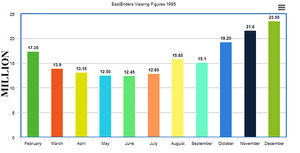
At launch, EastEnders was shown on BBC One. New Zealand became the first international country to broadcast EastEnders overseas, the first episode being shown on 27th September 1985.
The first episode was watched by 17 million viewers. Ratings fluctuated over the following months before jumping to 23.55 million for the ninetieth and second to last episode of the year. The average for the year was 14.50 million viewers.
Doof-Doof Count
Note: Doof-doofs are based on which character(s)/face(s) appeared at the end of an episode in frame.
| Character | Solo | Group | Total | Julia's Theme |
|---|---|---|---|---|
| Angie Watts | 12 | 3 | 15 | No |
| Kathy Beale | 5 | 4 | 9 | No |
| Den Watts | 5 | 2 | 7 | Yes |
| Pauline Fowler | 5 | 2 | 7 | No |
| Michelle Fowler | 6 | 0 | 6 | No |
| Pete Beale | 3 | 3 | 6 | No |
| Sue Osman | 3 | 2 | 5 | Yes |
| Debbie Wilkins | 4 | 0 | 4 | No |
| Ali Osman | 2 | 2 | 4 | Yes |
| Naima Jeffery | 3 | 1 | 4 | No |
| Ian Beale | 1 | 3 | 4 | Yes |
| Lou Beale | 1 | 3 | 4 | Yes |
| Saeed Jeffery | 3 | 1 | 4 | No |
| Tony Carpenter | 2 | 2 | 4 | No |
| Arthur Fowler | 1 | 3 | 4 | No |
| Kelvin Carpenter | 2 | 1 | 3 | No |
| Mark Fowler | 2 | 1 | 3 | No |
| Ethel Skinner | 1 | 2 | 3 | No |
| Nick Cotton | 3 | 0 | 3 | No |
| Non character | 3 | 0 | 3 | No |
| Mary Smith | 1 | 1 | 2 | No |
| Sharon Watts | 1 | 1 | 2 | No |
| Doctor Harold Legg | 1 | 0 | 1 | No |
| George 'Lofty' Holloway | 1 | 0 | 1 | No |
| Simon 'Wicksy' Wicks | 1 | 0 | 1 | No |
| Cassie Carpenter | 0 | 1 | 1 | No |
| Hassan Osman | 0 | 1 | 1 | No |
| Melanie | 0 | 1 | 1 | No |
| Martin Fowler | 0 | 1 | 1 | No |
| Sheena Mennell | 0 | 1 | 1 | No |
Director and Writer Count
The 1985 episodes were directed by 14 directors and written by 27 writers.
Directors
| Ranking | Director | Number of Episodes |
|---|---|---|
| 1 | Matthew Robinson | 13 |
| 2 | Antonia Bird | 12 |
| 3 | Sue Butterworth | 10 |
| 4 | Jeremy Ancock | 6 |
| Stephen Butcher | 6 | |
| Chris Clough | 6 | |
| Peter Edwards | 6 | |
| Mike Gibbon | 6 | |
| Brian Morgan | 6 | |
| William Slater | 6 | |
| Malcolm Taylor | 6 | |
| 5 | Robert Gabriel | 4 |
| 6 | Julia Smith | 3 |
| 7 | Vivienne Cozens | 1 |
Writers
| Ranking | Writer | Number of Episodes |
|---|---|---|
| 1 | Bill Lyons | 15 |
| 2 | Jane Hollowood | 12 |
| 3 | Valerie Georgeson | 8 |
| 4 | Michael Robartes | 7 |
| 5 | Rosemary Mason | 6 |
| 6 | Gerry Huxham | 5 |
| Tony McHale | 5 | |
| 7 | Gilly Fraser | 4 |
| Jim Hawkins | 4 | |
| 8 | Juliet Ace | 2 |
| Chris Anstis | 2 | |
| Liane Aukin | 2 | |
| Peter Batt | 2 | |
| Bev Doyle | 2 | |
| Harry Duffin | 2 | |
| Glen McCoy | 2 | |
| 9 | David Ashton | 1 |
| Susan Boyd | 1 | |
| John Crisp | 1 | |
| Tony Dennis | 1 | |
| Frances Galleymore | 1 | |
| Billy Hamon | 1 | |
| Tony Holland | 1 | |
| Charlie Humphreys | 1 | |
| Hugh Miller | 1 | |
| Christopher Russell | 1 | |
| Allan Swift | 1 |
Storylines
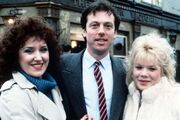
February
- Reg Cox, who has been missing for three days, is found dead in his armchair when Den Watts, Ali Osman and Arthur Fowler break down his door. Detective Sergeant Rich isn't convinced the death is due to natural causes.
- Doctor Harold Legg confirms Pauline Fowler's pregnancy, but when Lou Beale hears the news she's furious and orders her daughter to 'get rid of it' - she won't have a baby in her house.
- Jobless Arthur is offered a few weeks' works by builder Tony Carpenter.
- Sue and Ali Osman at the café start up a Golden Circle money chain letter.
- Den, when not phoning his mistress, Jan Hammond, is ducking and diving and following up one dodgy deal or another.
- When Nick Cotton argues with Ali about Reg Cox, Den bans them both from the pub.
March
- Michelle Fowler and her best friend, Sharon Watts, compete to go out with Kelvin Carpenter.
- DS Rich quizzes George 'Lofty' Holloway about the Luftwaffe badge that Mark Fowler gave him. It brings on one of Lofty's asthma attacks.
- Mary Smith and baby Annie Smith move into Reg's room.
- Heroin addict Nick Cotton is stopped by Ethel Skinner from persuading Mary to go on the game, so she takes up embroidery at slave wage rates instead.
- Racist slogans are painted on the front of the food store, the handiwork of members of the New Movement that Nick wants Lofty and Mark to join. It earns Nick a walloping from Tony.
April
- Naima Jeffery confides to Pauline that she doesn't sleep with Saeed Jeffery.
- Pete Beale teases Ian Beale about his cooking. He tells his gran he's unhappy but Kathy Beale, his mum, reacts angrily when Lou offers advice.
- Ian also tells of the part Nick and Mark played in the attack on the food store.
- Nick Cotton's arrest is reported.
- Pauline packs Lou and Michelle off to Clacton.
- Mark runs away.
- Debbie Wilkins begins a Save Our Square campaign after hearing of a redevelopment threat.
- Angie Watts discovers that Den, in Spain, is with another woman, probably Jan. Hurt, she retaliates by seducing Tony.
- Michelle and Lou return from Clacton, with Michelle fantasising about a waiter called Carlo.
May
- Ian takes over cooking the snacks at the Queen Vic and plans a party. With Kelvin, he teases Michelle by inviting a 'Carol' - really their pal Spotty.
- Sharon realises what's happening between Tony and her mother. Angie tells her about her dad's jaunt with Jan. When Den returns, they agree to end their affairs and try again but a night in the same bed is a failure.
- Mary's anxious father, Chris Smith, arrives.
- Doctor Legg is busy - Lou has shingles, Arthur is depressed at not finding any work and Sharon wants to go on the pill (to tempt Kelvin).
- Pauline has a bad turn and is taken to the hospital.
June
- Lou stays with Pete and Kathy for a while - they find it a strain.
- Tony is upset to see Sharon wearing the bracelet he gave to Angie as a love token and snubs Angie the next time he sees.
- Kelvin and Michelle split up.
- Unhappy Sharon complains to her mother about her heavy drinking, then steals some gin and gets drunk herself.
- Ali stakes his café and car in a poker game but wins. Before he and Sue can enjoy his luck they find their baby Hassan Osman has died in his cot in the night. They take him to Andy O'Brien, who is a nurse, but it's too late to revive him.
- Lofty and Michelle help Ali and Sue by running the café.
July
- Hassan's funeral takes place. Sue is numb.
- Dot Cotton, Pauline's partner at the laundrette, turns up late, upset about the gossip circulating about her Nick, who is due in court. He gets off, with probation.
- Michelle streaks Lofty's hair and it ends up green.
- Saeed argues with Naima about her sex ban.
- Angie and Den argue because of Angie's drinking.
- When Lou hears that Michelle has moved into her room, she insists on returning home to reclaim it. She loans Michelle money for a motorbike.
- Ian and Kelvin go into the knitting business together.

August
- Pauline has a baby boy - Martin Fowler.
- Doctor Legg thrusts Mary's little Annie into Sue's arms and Sue starts to grieve properly. She takes Hassan's clothes in a Tesco carrier bag to a none-too-delighted Pauline.
- At a charity night at the Vic, Angie is drinking heavily again and tries to auction her underwear. Den books her into a health farm.
- Pete accuses Arthur of being lazy.
- Mary tells Pauline that she can't read and that she's up in court for shoplifting.
- Michelle, peeved about her baby brother and her father's new job as a cleaner at her school, starts going out at night and drinking. She has a couple of after-hours chats with Den. One night, unseen by anyone, they make love.
September
- Someone is sending poison pen letters.
- Baby Martin has gastroenteritis and his christening is postponed.
- Sharon, upset about her parents' quarrelling, flirts with Lofty. Den is furious and hits her.
- Nick returns and Ethel locks herself indoors in fear.
- Michelle confides to Lou she's pregnant and a test confirms it. She refuses to name the father. Soon everyone is discussing what to do about it.
- Andy gives Debbie two kittens to make up for the fact that after they were burgled he found he'd forgotten to renew their insurance policy.
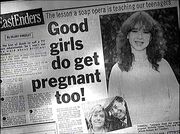
October
- Michelle arranges to meet the father of her unborn child by the canal. It's Den and she tells him that she won't have an abortion.
- Simon 'Wicksy' Wicks, Pete's son from his first marriage, arrives, upsetting Kathy and Ian. He offers to move on.
- There have been break-ins at the laundrette and Doctor Legg's surgery. Kathy's medical notes are missing.
- Saeed plans to sell up and return to Bangladesh.
- Nick tells Kathy that he knows she had a baby when she was fourteen and demands money to keep quiet.
- Sheena Mennell, Mary's stripper friend, persuades her to take up stripping.
- Martin is christened, with Wicksy standing in for Den as a godfather.
November
- Mary begins work as a stripper.
- Sheena babysits Annie one night but abandons her when she picks up a man. Sue rescues the child.
- Nick blackmails Kathy again.
- Angie tells Den that she wants to meet Jan, her rival.
- Ian prepares for a boxing match and he wins, thanks to Pete's encouragement and Wicksy's coaching.
- Lou keeps falling over and seems unwell.
- Kelvin's hopes for a reconciliation between his parents are dashed when his mother, Hannah Carpenter, reveals there's another man, Neville, in her life.
- The men in the Square debate suitable punishments for Nick over his behaviour to Kathy.
December
- The thief at the Vic turns out to be Sharon.
- Angie drives Den's car to a darts match but she comes home in the car worse for wear at 3:00 am.
- Lou, home from the hospital, is grumpy about sleeping downstairs and using a commode. Pete makes things worse by telling her she's now past working on the stall.
- Saeed is in the audience when Mary strips - he's lonely because Naima wants a divorce.
- Debbie and Andy get engaged.
- On Boxing Day, Cassie Carpenter turns up at her father's house, covered in bruises; Neville has been hitting her.
- After Christmas, Arthur and Pauline hear that Mark is in Southend. They track him down, and find him living with a woman whose two kids call him 'Daddy'.
Who lives where
Albert Square
- The Queen Victoria - Den, Angie and Sharon Watts. Simon 'Wicksy' Wicks (October onwards)
- 1B Albert Square - Ethel Skinner
- 1C Albert Square - George 'Lofty' Holloway
- 3B Albert Square - Tony Carpenter. Kelvin Carpenter (April onwards), Cassie Carpenter (December onwards)
- 23A Albert Square - Ali and Sue Osman, Hassan Osman (until June)
- 23B Albert Square - Mary and Annie Smith (March onwards)
- 43 Albert Square - Andy O'Brien and Debbie Wilkins
- 45 Albert Square - Lou Beale, Pauline Fowler, Arthur Fowler, Michelle Fowler. Mark Fowler (until April), Martin Fowler (August onwards)
- 47B Albert Square - Naima Jeffery, Saeed Jeffery (until December)
Walford Towers
- Flat 14B - Pete Beale, Kathy Beale, Ian Beale
- Unknown flat number - Dot Cotton
Other places
- Islington - Doctor Harold Legg
Production
Conception
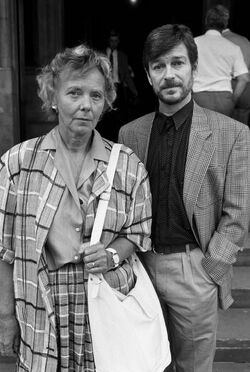
In March 1983, under two years before EastEnders' first episode was broadcast, the show was a vague idea in the mind of a handful of BBC executives, who decided that BBC1 needed a popular bi-weekly drama series that would attract the kind of mass audiences that ITV were getting with Coronation Street. The first people to whom David Reid, then head of series and serials, turned were Julia Smith and Tony Holland, a well-established producer/script editor team who had first worked together on Z-Cars. The outline that Reid presented was vague: two episodes a week, 52 weeks a year. After the concept was put to them on 14th March 1983, Smith and Holland then went about putting their ideas down on paper; they decided the setting would be in the East End of London. Granada Television gave Smith unrestricted access to the Coronation Street production for a month so that she could get a sense how a continuing drama was produced. There was anxiety at first that the viewing public would not accept a new soap set in the south of England, though research commissioned by lead figures in the BBC revealed that southerners would accept a northern soap, northerners would accept a southern soap and those from the Midlands.
The show's creators were both Londoners, but when they researched Victorian squares, they found massive changes in areas both thought they knew well. However, delving further into the East End of London, they found precisely what they had been searching for: a real East End spirit - an inward-looking quality, a distrust of strangers and authority figures, a sense of territory and community that the creators summed up as "Hurt one of us and you hurt us all".
Formal commission
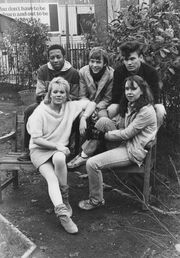
The target launch date was originally January 1985. Smith and Holland had eleven months in which to write, cast and shoot the whole thing. However, in February 1984, they did not even have a title or a place to film. Both Smith and Holland were unhappy about the January 1985 launch date, favouring November or even September 1984 when seasonal audiences would be higher.
The project had some working titles - Square Dance, Round the Square, Round the Houses, London Pride and East 8. It was the latter that stuck (E8 is the postcode for Hackney) in the early months of the creative process. However, the show reluctantly renamed after many casting agents mistakenly thought the show was to be called Estate, and the fictional postcode E20 sprang to life, instead of using E8. Julia Smith came up with the name Eastenders after she and Holland had spent months telephoning theatrical agents and asking "Do you have any real East Enders on your books?" However, Smith thought "Eastenders" "looked ugly written down" and was "hard to say", so decided to capitalise the second 'e.'
Pre-production
After they decided on the filming location of BBC Elstree Centre in Hertfordshire, Smith and Holland set about creating the 23 characters needed, in just 14 days. They took a holiday in Playa de Los Pocillos, Lanzarote, and started to create the characters.

Holland created the Beale and Fowler family, drawing on his background. His mother, Ethel Holland, was one of four sisters raised in Walthamstow. Her eldest sister, Lou, had married a man named Albert Beale and had two children, named Peter and Pauline. These family members were the basis for Lou Beale, Pete Beale and Pauline Fowler. Holland also created Pauline's unemployed husband Arthur Fowler, their children Mark Fowler and Michelle Fowler, Pete's wife Kathy Beale and their son Ian Beale.
Smith used her memories of East End residents she met when researching Victorian squares. Ethel Skinner was based on an old woman she met in a pub, with ill-fitting false teeth, and a "face to rival a neon sign", holding a Yorkshire Terrier in one hand and a pint of Guinness in the other. Other characters created included Jewish doctor Harold Legg, the Anglo-Cypriot Osman family, Ali Osman, Sue Osman and baby Hassan Osman, black father and son, Tony Carpenter and Kelvin Carpenter, single mother Mary Smith and Bangladeshi couple Saeed Jeffery and Naima Jeffery. Jack, Pearl and Tracey Watts were created to bring "flash, trash, and melodrama" to the Square (they were later renamed Den, Angie and Sharon Watts).
The characters of Andy O'Brien and Debbie Wilkins were created to show a modern couple with outwardly mobile pretensions, and Lofty Holloway to show an outsider; someone who did not fit in with other residents. The decision concluded that he would be a former soldier, as Holland's personal experiences of ex-soldiers were that they had trouble fitting into society after being in the army.
When they compared the characters they had created, Smith and Holland realised they had created a cross-section of East End residents. The Beale and Fowler family represented the old families of the East End, who had always been there. The Osmans, Jeffreys and Carpenters served the more modern diverse ethnic community of the East End. Debbie, Andy and Mary represented more modern-day individuals.
The show was planned to start with a bang with the death of elderly resident Reg Cox, but Smith and Holland decided that none of their existing characters was wicked enough to have killed Reg, so a 24th character, Nick Cotton was added to the line-up. He was a racist thug, who often tried to lead other young aspects astray.
The Building of Albert Square
Overseeing the building of the square was senior designer Keith Harris, who had spent the past 19 years working on various BBC productions. Albert Square was to be one of the largest exterior sets ever built for British TV production. From the outset, Keith worked closely with creators Julia Smith and Tony Holland. As the storylines developed, so too did the ideas for the homes and habitats of the characters. One of the first things was the exact siting of the street and houses in the square. Also taken into consideration was the amount of possible 'nuisance' that the set might cause to the surrounding neighbourhood. Taking all these points into account, Keith Harris took the first steps in the birth of Albert Square, by drawing up his first plans - with a stink in the sand!

The next step was the draining of the site via an elaborate system of trenches which would also carry cables for camera pick-up points around the square. Cardboard models were then produced and discussed, together with plans for the interior sets. A great deal of research went into the quest for accuracy and realism. This included following exact proportions, as laid down by Victorian architects and builders. Many photographs were taken of real Victorian squares in Hackney and Bethnal Green.
In May 1984, the site was cleared ready for the building of Albert Square. Outside contractors were called in to carry out the 'hard landscaping' of the site - laying drains, road and pavements, and erecting the steel framework for each block of dwellings. The outer shell of each building in the square was made by a small army of artisans in the BBC's construction workshop. These shells, made of plywood and plaster, were then bolted onto the rigid framework.
When finished, each structure, or block, was complete on at least three sides. Inside each one, at the first-floor level, is a metal platform used for any action involving characters at an upstairs window. Each of the buildings is strong enough to withstand high winds or heavy gales - even the roofs are fully strengthened. Thousand-and-one other details had to be attended to: period doors were brought in from a demolition company, sash window frames were constructed, together with authentic-looking drainpipes, chimney stacks and window panes. Even details of the brickwork are authentic, being made from fibreglass moulds taken from a whole East End brick wall. The same method was used for fine detail in archways, lintels, bay windows, and of slates and pilasters.
Once the set was erected, it then had to be 'aged' - after all, it was supposed to have stood there for more than a hundred years. This was achieved in a number of ways: pavements were deliberately chipped and cracked, paintwork was given a gnarled, uneven look by means of a particular chemical which breaks the top coat, damp patches were added to the underside of the railway bridge by using varnish, garden walls were made to sag and so on. The finishing touches were finally added towards the end of the summer 1984 - a telephone kiosk and telegraph pole from British telecom, lampposts from the Hertsmere Borough Council, and several cars and vans to park in the streets.
While the exterior set was being created, work was also underway on the interiors. The Queen Vic, Al's Café, the Launderette and Lou Beale's house were among the first to be built. In each set, all appliances - gas, water, etc. - were fully functional. The design of each interior began with a thorough study of the characters who would 'live' within its walls. As with the exterior, attention to detail was the keynote to a strong effect.
All the props - furniture, curtains, crockery etc. - were chosen with great care so as not to be at odds with the tastes of the characters using them. In the older homes, everything had to have its history of marks, stains, sags, scratches and so on - so that the viewers would accept and believe in them.
Transmission
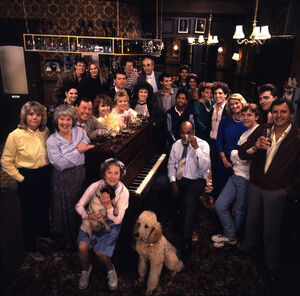
The first episode was broadcast at 7pm on Tuesday 19th February 1985. Both Holland and Smith could not watch and the next day, viewing figures were confirmed at 17 million, The reviews were largely favourable, although, after three weeks on air, BBC1's early evening share had returned to the pre-EastEnders figure of seven million, though EastEnders then climbed to highs of up to 23 million later on in the year.
Following the launch, both group discussions and telephone surveys were conducted to test audience reaction to early episodes. Detailed reactions were taken after six months and since then regular monitoring was conducted.
Public and press reactions
Press coverage of EastEnders, which was already intense, went into overdrive once the show was broadcast. With public interest so high, the media began investigating the private lives of the show's popular stars. Within days, a scandalous headline appeared: "EASTENDERS STAR IS A KILLER". This referred to Leslie Grantham and his prison sentence for the murder of a taxi driver in an attempted robbery nearly 20 years earlier. This shocking tell-all style set the tone for relations between Albert Square and the press for the next 20 years.
By Christmas 1985, the tabloids couldn't get enough of the show. 'Exclusives' about EastEnders storylines and the actors on the show became a staple of tabloid buyers daily reading.
Promotional Photos
| 1980's ▬ 1990's ▬ 2000's ▬ 2010's ▬ 2020's |
|---|
| 1985 • 1986 • 1987 • 1988 • 1989 → |

